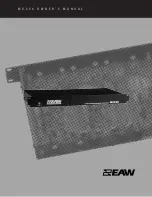
On-Net Surveillance Systems, Inc.
NetDVMS 6.5e
Administration
29
o
Repair, Scan, Delete if fails
: Default action. If the database becomes corrupted, two
different repair methods will be attempted: a fast repair and a thorough repair. If both repair
methods fail, the contents of the database will be deleted.
o
Repair, Delete if fails
: If the database becomes corrupted, a fast repair will be attempted. If
the fast repair fails, the contents of the database will be deleted.
o
Repair, Archive if fails
: Available only if archiving is enabled for the camera. If the database
becomes corrupted, a fast repair will be attempted. If the fast repair fails, the contents of
the database will be archived. This action is recommended if archiving is enabled for the
camera.
o
Delete (no repair)
: If the database becomes corrupted, the contents of the database will be
deleted.
o
Archive (no repair)
: Available only if archiving is enabled for the camera. If the database
becomes corrupted, the contents of the database will be archived.
Tip:
Provided the corrupt database has been
archived
, it can be repaired by the
Viewer
:
Open the
Viewer
and attempt to browse the archived recordings from the camera in
question. Browsing will initially fail, but this will make the
Viewer
start repairing the corrupt
database.
Tip:
See also How to Protect Databases from Corruption.
When the contents of the local database for the camera are either deleted or archived, the
database is reset and will be ready for storing new recordings.
Note:
No video can be recorded while the database is being repaired. For large installations, a
repair may take several hours, especially if the
Repair, Scan, Delete if fails
action involving two
different repair methods is selected, and the first repair method (fast repair) fails.
Database Resizing
In case recordings for a camera get bigger than expected, or the available drive space is suddenly reduced
in another way, an advanced database resizing procedure will automatically take place:
If archives are present on the same drive as the camera's database, the oldest archive for all cameras
archived on that drive will be deleted.
If no archives are present on the drive containing the camera's database, the size of all camera databases
on the drive will be reduced by deleting a percentage of their oldest recordings, thus temporarily limiting the
size of all databases
When the recording server is restarted upon such database resizing, the original database sizes will be used.
You should therefore make sure the drive size problem is solved, or adjust camera database sizes to reflect
the altered drive size.
Tip:
Should the database resizing procedure take place, you will be informed on-screen in NetGuard-
EVS, in log files, and (if set up) through an e-mail alert.
Tip:
For more information about how NetDVMS responds to the threat of running out of disk space, see
About Archiving
.















































